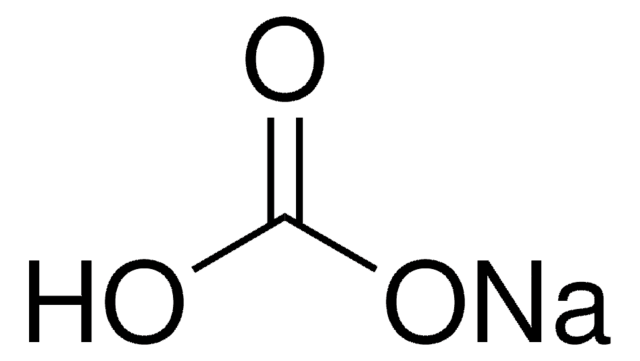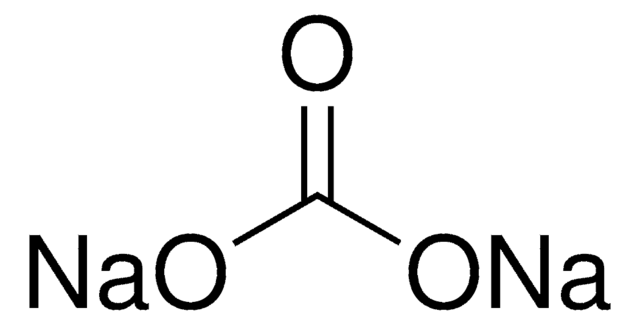S6014
Sodium bicarbonate
ACS reagent, ≥99.7%
Synonym(s):
Sodium hydrogen carbonate
Select a Size
Select a Size
About This Item
Recommended Products
grade
ACS reagent
Agency
suitable for EPA 1621
suitable for EPA 300
Assay
≥99.7%
99.7-100.3%
form
powder
impurities
≤0.015% Insoluble matter
pKa (25 °C)
(1) 6.37, (2) 10.25 (carbonic acid)
density
2.16 g/mL at 25 °C (lit.)
anion traces
chloride (Cl-): ≤0.003%
phosphate (PO43-): ≤0.001%
sulfur compounds (as SO42-): ≤0.003%
cation traces
Ca: ≤0.02%
Fe: ≤0.001%
K: ≤0.005%
Mg: ≤0.005%
NH4+: ≤5 ppm
heavy metals: ≤5 ppm (by ICP-OES)
SMILES string
[Na+].OC([O-])=O
Looking for similar products? Visit Product Comparison Guide
Related Categories
1 of 4
This Item | S8875 | S5761 | 792519 |
|---|---|---|---|
| assay ≥99.7%, 99.7-100.3% | assay ≥99.5% | assay 99.5-100.5% | assay ≥99.7% |
| Quality Level 300 | Quality Level 200 | Quality Level 300 | Quality Level 100 |
| grade ACS reagent | grade - | grade for molecular biology | grade ACS reagent, anhydrous |
| impurities ≤0.015% Insoluble matter | impurities - | impurities - | impurities ≤0.015% insoluble matter |
| cation traces Ca: ≤0.02%, K: ≤0.005%, NH4+: ≤5 ppm, Fe: ≤0.001%, heavy metals: ≤5 ppm (by ICP-OES), Mg: ≤0.005% | cation traces - | cation traces - | cation traces Ca: ≤0.02%, Fe: ≤0.001%, K: ≤0.005%, Mg: ≤0.005%, NH4+: ≤5 ppm, heavy metals: ≤5 ppm (by ICP-OES) |
General description
Application
- Contactless conductivity sensor employing moist paper as absorbent for in-situ detection of generated carbon dioxide gas.: This study utilizes sodium bicarbonate in a novel approach for the development of a contactless conductivity sensor. The sensor uses moist paper to absorb CO2 gas generated from sodium bicarbonate, demonstrating its potential for environmental monitoring and analytical applications (Sonsa-Ard et al., 2020).
- mild base to neutralize the reaction mixture during the synthesis of 1,2:5,6-Di-O-cyclohexylidene-D-mannitol, and 2,3-Cyclohexylidene-D-glyceraldehyde.[3]
- precipitating agent in the co-precipitation method in the synthesis of gamma alumina (γ-Al2O3) catalyst during the methanol dehydration reaction to produce Dimethyl ether. [4]
- a pore-forming agent and CO2 source to enhance the substrate porosity during the formation of a porous poly(ethersulfone) support layer for designing high-performance thin-film composite forward osmosis (TFC-FO) membranes. [5]
Other Notes
Legal Information
Storage Class Code
13 - Non Combustible Solids
WGK
WGK 1
Flash Point(F)
Not applicable
Flash Point(C)
Not applicable
Choose from one of the most recent versions:
Certificates of Analysis (COA)
Don't see the Right Version?
If you require a particular version, you can look up a specific certificate by the Lot or Batch number.
Already Own This Product?
Find documentation for the products that you have recently purchased in the Document Library.
Related Content
This page is intended to make it easier to find the consumables you need based on the analytical method you’re using. Methods included on this page come from the EPA, Standard Methods and ASTM.
Our team of scientists has experience in all areas of research including Life Science, Material Science, Chemical Synthesis, Chromatography, Analytical and many others.
Contact Technical Service

